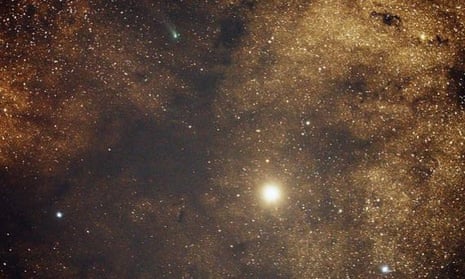An extremely rare celestial event will play out on Sunday night, with an ancient comet hurtling narrowly past Mars, prompting observing spacecraft to take evasive action.
The comet, called Siding Spring – or more formally as C/2013 A1 – will pass within 140,000km of Mars at a speed of around 56km a second. This distance is equivalent to a comet passing at a third of the distance between the Earth and the moon.
Siding Spring is named after the New South Wales observatory where the comet’s path was first spotted by astronomer Rob McNaught in January last year.
Dr Michael Brown, an astronomer at Monash University, said the hurtling comet’s fly-past of Mars is “extremely rare”.
“It’s the closest passing of a planet we’ve seen since a comet crashed into Jupiter around 20 years ago,” he said. “It’s lucky we have a flotilla of spacecraft near Mars so we can take pictures. It’s a useful coincidence, scientifically.”
Nasa’s Mars rovers, Opportunity and Curiosity, will potentially have a good view of the comet, while data will also be gathered by the space agency’s three orbiting spacecraft.
However, the dust given off by the icy comet poses a potentially devastating risk to the spacecraft, so Nasa has adopted a “duck and cover” strategy of hiding the orbiters behind Mars as the comet passes. The European Space Agency has also altered the orbit of its monitoring craft, as has India.
It is hoped data will be gathered from the comet, which is thought to be debris from the formation of the solar system 4.5bn years ago. It previously gave the sun a very wide berth in its orbit, taking several million years to loop past the star.
“It has probably been left in the outer part of the solar system in a cold, frozen orbit for a very long time before something disturbed its orbit and pushed it into our neck of the solar system,” Brown said.
“It has probably never been so close to the sun in all that time. It’s essentially a refrigerator of pristine parts of the creation of the solar system. The particles it gives off are effectively opening up the door of the fridge so we can see what the solar system was like 4.5 billion years ago.
“It will give off a lot of dust which can do a hell of a lot of damage if it hits a spacecraft at 50km a second, so hopefully Nasa will be able to protect them.”
Scientists will also be able to observe how the passing of the comet, and its plume of dust, affects the atmosphere around Mars.
“It is possible that the atmosphere of the comet will interact with the atmosphere of Mars,” said David Brain of the University of Colorado’s Laboratory for Atmospheric and Space Physics.
“This could lead to some remarkable effects, including Martian auroras. Any auroras we see will not only be neat, but also very useful as a diagnostic tool for how the comet and the Martian atmosphere have interacted.”
It will be possible to see the comet through a telescope, although the distance will make the object appear very faint. The snowball at the comet’s centre is just 400m wide.
Australians are best advised to look for the comet’s approach on Sunday night – the actual passing of the object at around 5am eastern time on Monday will occur when Mars is below the horizon.
The best time to look in the UK is around 6.30pm, while US comet-spotters are advised to look at around 2.30pm eastern time.

Comments (…)
Sign in or create your Guardian account to join the discussion